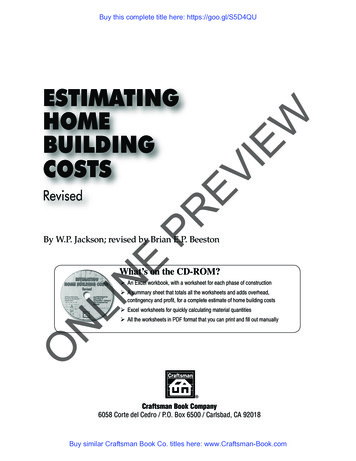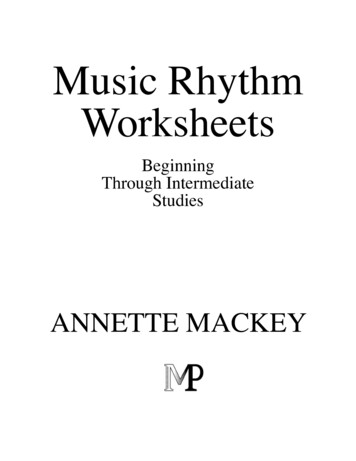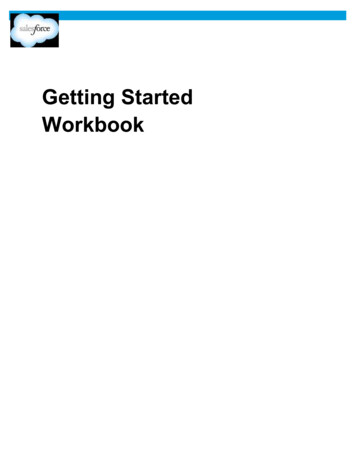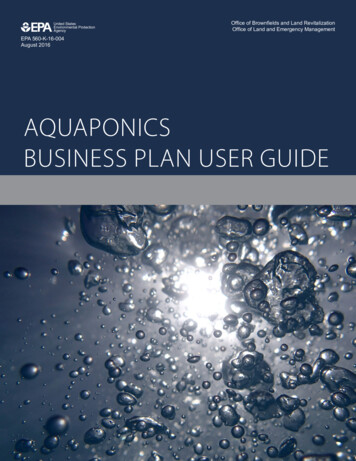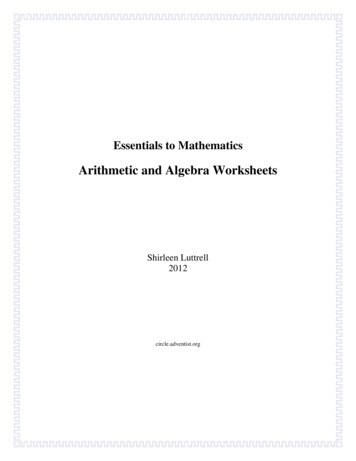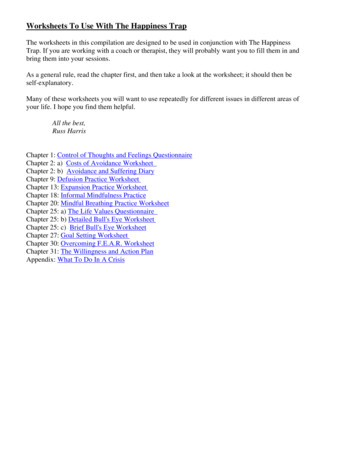
Transcription
Worksheets To Use With The Happiness TrapThe worksheets in this compilation are designed to be used in conjunction with The HappinessTrap. If you are working with a coach or therapist, they will probably want you to fill them in andbring them into your sessions.As a general rule, read the chapter first, and then take a look at the worksheet; it should then beself-explanatory.Many of these worksheets you will want to use repeatedly for different issues in different areas ofyour life. I hope you find them helpful.All the best,Russ HarrisChapter 1: Control of Thoughts and Feelings QuestionnaireChapter 2: a) Costs of Avoidance WorksheetChapter 2: b) Avoidance and Suffering DiaryChapter 9: Defusion Practice WorksheetChapter 13: Expansion Practice WorksheetChapter 18: Informal Mindfulness PracticeChapter 20: Mindful Breathing Practice WorksheetChapter 25: a) The Life Values QuestionnaireChapter 25: b) Detailed Bull's Eye WorksheetChapter 25: c) Brief Bull's Eye WorksheetChapter 27: Goal Setting WorksheetChapter 30: Overcoming F.E.A.R. WorksheetChapter 31: The Willingness and Action PlanAppendix: What To Do In A Crisis
How to Get the Most Out Of ‘The Happiness Trap’Reading the BookThere are two ways to read the book. You can either work through it slowly and steadily, doing the exercisesas you go. Or you can read it from cover to cover very rapidly, and then go back and work through it at yourleisure. You can also enhance the exercises in the book by using the free online resources athttp://www.thehappinesstrap.com/free resourcesStuck or Confused?If you ever get stuck or confused, I’d suggest you join the Yahoo list serve, entitled ‘ACT for the Public’:http://health.groups.yahoo.com/group/ACT for the Public/joinThere’s no cost involved. You can post emails to the group if ever you are confused, or concerned, or justbogged down – and you will quickly receive supportive responses from other members of the public and/orfrom the many therapists (including myself) who are also on the list.Prioritize Your Health and WellbeingIf you are a typical reader, then you are already a very busy person. You are juggling multiple demands andrarely have any time left over for yourself. Thus, if you want this book to make a real difference in your life,you will have to put your health and wellbeing above some of the other demands upon your time. Can youschedule in some time for reading? Can you schedule in some time for practicing the exercises? Even 30minutes a day to read and/or practice can make a huge difference. Are you willing to give up 30 minutes of TVor other time-eating activities?PracticeWhoever said “Practice makes perfect” was lying. But practice does lead to improvement. Like any new skills,the exercises and strategies in this book do require practice – they do not come naturally, or magicallyhappen simply as a result of reading. And like any new skill, the more you practice it, the easier it becomesand the more naturalistic.Be PatientBe patient with yourself. As you work through the book, there are times when you will inevitably screw up, fail,and forget things. This is because you are a human being, not a saint or a guru or a superhero. So please,allow yourself permission to be human. And give yourself as much time as you need to get a good handle onyour new skills.Consider Using a CD or MP3 RecordingThe CDs and MP3 recordings available from www.thehappinesstrap.com have been specifically designed foruse with this book. They will substantially enhance the benefits of the book for you. Mindfulness skills aremuch easier to develop initially when you have a voice guiding you.RepetitionI intended The Happiness Trap to be the sort of book that you read not just once, but again and again. Myhope is that after you’ve been through it once, you repeatedly revisit it. The small chapters make it an idealbook for dipping into.Working With a Coach or Therapist:While The Happiness Trap is primarily written as a self-help book for use on your own, it is also a valuableadjunct to therapy and coaching. Indeed the book flows along, chapter by chapter, in much the same way asyou might typically work with a coach or therapist. If your therapist or coach has done some training in ACTthey will be familiar with many of the exercises and metaphors in the book, but probably not all of them, so itis a good idea if they read the book too.You can use the book as an adjunct in two main ways:1. You can read a chapter or two (or three) before each session, then discuss in session how the readingapplies to you, and then practice the relevant exercises during the session.2. You can read relevant chapters after a session, to build on what you have experienced or learned duringthe session.Whichever way you do it, the worksheets from the free resources section can be very helpful; use them asyou are reading the relevant chapter.To Find an ACT TherapistIf you want to find an ACT therapist in Australia, click hereIf you want to find an ACT therapist in USA, UK and other countries, click hereI hope you enjoy reading it and I trust you’ll find it helpfulCheers, Russ Harris
Control of Thoughts and Feelings QuestionnaireThis questionnaire has been adapted from similar ones developed by Steven Hayes, Frank Bond, and others. For each pair ofstatements, please circle the one that most accurately fits how you feel. The answer you choose doesn’t have to be absolutely100 percent true for you all the time; just pick the answer which seems to be more representative of your general attitude.1a. I must have good control of my feelings in order to be successful in life.1b. It is unnecessary for me to control my feelings in order to be successful in life.2a. Anxiety is bad.2b. Anxiety is neither good nor bad. It is merely an uncomfortable feeling.3a. Negative thoughts and feelings will harm you if you don’t control or get ridof them.3b. Negative thoughts and feelings won’t harm you even if they feel unpleasant.4a. I’m afraid of some of my strong feelings.4b. I’m not afraid of any feelings, no matter how strong.5a. In order for me to do something important, I have to get rid of all my doubts.5b. I can do something important, even when doubts are present.6a. When negative thoughts and feelings arise, it’s important to reduce or get rid of them as quickly as possible.6b. Trying to reduce or get rid of negative thoughts and feelings frequently causes problems. If I simply allow them to be, thenthey will change as a natural part of living.7a. The best method of managing negative thoughts and feelings is to analyze them; then utilize that knowledge to get rid ofthem.7b. The best method of managing negative thoughts and feelings is to acknowledge their presence and let them be, withouthaving to analyze or judge them.8a. I will become “happy” and “healthy” by improving my ability to avoid, reduce, or get rid of negative thoughts and feelings.8b. I will become “happy” and “healthy” by allowing negative thoughts and feelings to come and go of their own accord andlearning to live effectively when they are present.9a. If I can’t suppress or get rid of a negative emotional reaction, it’s a sign of personal failure or weakness.9b. The need to control or get rid of a negative emotional reaction is a problem in itself.10a. Having negative thoughts and feelings is an indication that I’m psychologically unhealthy or I’ve got problems.10b. Having negative thoughts and feelings means I’m a normal human being.11a. People who are in control of their lives can generally control how they feel.11b. People who are in control of their lives do not need to control their feelings.12a. It is not okay to feel anxious and I try hard to avoid it.12b. I don’t like anxiety, but it’s okay to feel it.13a. Negative thoughts and feelings are a sign that there is something wrong with my life.13b. Negative thoughts and feelings are an inevitable part of life for everyone.14a. I have to feel good before I can do something that’s important and challenging.14b. I can do something that’s important and challenging even if I’m feeling anxious or depressed.15a. I try to suppress thoughts and feelings that I don’t like by just not thinking about them.15b. I don’t try to suppress thoughts and feelings that I don’t like. I just let them come and go of their own accord.To score your test, count the number of times you selected option “a” or “b.”You may like to repeat this test and see how your ideas have changed, after you have finished reading The Happiness Trap, orcompleted several sessions of ACT. Russ Harris 2008www.thehappinesstrap.com
The Costs of Avoidance WorksheetComplete the following sentences:The thoughts I’d most like to get rid of are:The feelings I’d most like to get rid of are:The sensations I’d most like to get rid of are:The memories I’d most like to get rid of are:Next, take a few minutes to write a list of every single thing you’ve tried in order to avoid or get rid ofthese unpleasant thoughts or feelings. Try to remember every strategy you have ever used (whetherdeliberately or by default). Below is a guide to help you:Distraction: list everything you have ever done to distract yourself from, or ‘zone out’, or take yourmind off these painful thoughts, feelings, sensations or memories.Opting out: list all the activities, interests, events, people, or places that you have avoided or withdrawnfrom, and all the opportunities you have missed out on, because you did not feel good or wanted toavoid feeling bad: Russ Harris 2008www.thehappinesstrap.com
Thinking strategies: list all the different ways of thinking you have tried (deliberately orunintentionally) when painful thoughts and feelings started showing up. Tick any of the following thatyou have done, and write in any others: Worrying Dwelling on the past Fantasizing about the future Imagining escape scenarios (eg leaving your job or your partner) Imagining revenge scenarios Imagining suicide scenarios Thinking ‘It’s not fair ’ Thinking ‘If only .’ Thinking of killing yourself Blaming yourself Blaming others Blaming the world Talking logically to yourself Talking positively to yourself Talking negatively to yourself Analyzing yourself (trying to figure out why you are like this) Analyzing the situation (trying to figure out why this happened) Analyzing others (trying to figure out why they are like this)Substances: list all the substances you have ever used to try and feel better, including foods, drinks,cigarettes, recreational drugs, and prescription drugsAnything else: write down anything else you can think of you have ever tried to make yourself feel a bitbetter, or not so bad, when these painful thoughts and feelings showed up.Once you’ve done that, go through your list and for each item, ask yourself:1. Did this get rid of my painful thoughts and feelings in the long term?2. Did it bring me closer to a rich, full, and meaningful life?3. If the answer to question 2 is “no”, then what did this cost me in terms of time, energy, money, health,relationships, and vitality? Russ Harris 2008www.thehappinesstrap.com
AVOIDANCE & SUFFERING DIARYFill this in at least once a day, to increase awareness around the costs of trying to avoid or get rid of painful thoughtsand feelings.Painful Thoughts/ Feelings/Sensations/ Memoriesthat showed up today Russ Harris, 2008What I did to escape, avoid, get ridof them, or distract myself fromthemwww.thehappinesstrap.comWhat that cost me in terms ofhealth, vitality, relationship issues,getting stuck, increasing pain,wasted time/money/energy etc.
At the end of each day note the defusion techniques you used, in what situation, how often, whether defusion occurred,and any benefits and/or difficulties you noticed. Remember the aim of defusion is not to 'feel good' or to get rid of 'bad'thoughts; it is to help you 'be present' and reduce the influence of unhelpful thoughts and beliefs over your behavior.Defusion Practice FormName of technique (s)Practiced: yes/ noDay/DateIn what situation(s)?How often? Russ Harris 2008Did defusionoccur?yes/ no/ a littlewww.thehappinesstrap.comBenefits and/or difficulties
Expansion means opening up and making room for difficult feelings, urges and sensations – thereby allowing them to ‘flow through’you without a struggle. You don’t have to like or want these feelings – you just make room for them and allow them to be there eventhough they are unpleasant. Once this skill is learned, if these feelings should resurface, you can rapidly make room for them and letthem ‘flow on by’ – so you can invest your time and energy in doing meaningful life-enhancing activities, instead of struggling. Aim topractice at least once a day breathing into and making room for difficult feelings and sensationsExpansion Practice FormDay/Date/TimeFeelings/sensations Russ Harris 2008How many minutes of practice? Used ‘MindfulnessStruggle switch rating, 0 -10?Skills: Vol 1 CD’10 switch fully onyes/ no0 switch fully off (no struggle)www.thehappinesstrap.comBenefits and/or difficulties
Informal Mindfulness ExercisesWe’re all busy, and many of us don’t have time (or are unwilling to make time) to formally practice mindfulnessskills. However, we can practice informally throughout the day. Here are a couple of examples:1) Mindfulness in Your Morning RoutinePick an activity that constitutes part of your daily morning routine, such as brushing your teeth, shaving, or havinga shower. When you do it, totally focus on what you are doing: the body movements, the taste, the touch, thesmell, the sight, the sound etc.For example, when you’re in the shower, notice the sounds of the water as it sprays out of the nozzle, and as it hitsyour body as it gurgles down the hole. Notice the temperature of the water, and the feel of it in your hair, and onyour shoulders, and running down our legs. Notice the smell of the soap and shampoo, and the feel of themagainst your skin. Notice the sight of the water droplets on the walls or shower screen, the water dripping downyour body and the steam rising upwards. Notice the movements of your arms as you wash or scrub or shampoo.When thoughts arise, acknowledge them, let them be, and bring your attention back to the shower.Again and again, your attention will wander. As soon as you realize this has happened, gently acknowledge it,note what distracted you, and bring your attention back to the shower.2) Mindfulness of Domestic ChoresPick a chore that you normally try to rush through, or distract yourself from; or one for which you just ‘grit yourteeth’ and try to ‘get through it’. For example: ironing clothes, washing dishes, vacuuming floors, making thekids’ lunches. Aim to do this chore as a mindfulness practice.E.g., when ironing clothes: notice the color and shape of the clothing, and the pattern made by the creases, and thenew pattern as the creases disappear. Notice the hiss of the steam, the creak of the ironing board, the faint soundof the iron moving over the material. Notice the grip of your hand on the iron, and the movement of your arm andyour shoulder.If boredom or frustration arises, simply acknowledge it, and bring your attention back to the task at hand.When thoughts arise, acknowledge them, let them be, and bring your attention back to what you are doing.Again and again, your attention will wander. As soon as you realize this has happened, gently acknowledge it,note what distracted you, and bring your attention back to your current activity.Now write down some informal mindfulness exercises for yourself:During my morning routine, I will practice mindfulness of . .During my evening routine, I will practice mindfulness of .During the week, I will practice mindfulness of the following chore (s) .Now write down any other quick ’n’ easy informal mindfulness exercises you can think of – e.g. whilewaiting in queues or at traffic lights you could practice mindfulness of your impatience; or when eatingdinner, you could aim to eat the first two mouthfuls mindfully.At the end of each week, pull this sheet out and see how well you have followed it. Russ Harris 2007www.thehappinesstrap.com
Mindful breathing practice enables you to develop several skills: the ability to focus, and engage in what you are doing; the ability tolet thoughts come and go without getting caught up in them; the ability to refocus when you realize you are distracted; and the abilityto let your feelings be as they are without trying to control them. Even 5 minutes practice a day can make a difference over time. 10minutes twice a day or 20 minutes once a day is even better.Mindful Breathing Practice FormDay/Date/Time(s)How long I practiced for(minutes) Russ Harris 2008Difficult thoughts and feelingsthat showed upUsed ‘MindfulnessSkills: Vol 1 CD’yes/ nowww.thehappinesstrap.comBenefits and/or difficulties
VALUES WORKSHEET (Adapted from Kelly Wilson’s Valued Living Questionnaire)Deep down inside, what is important to you? What do you want your life to stand for? What sort of qualities do youwant to cultivate as a person? How do you want to be in your relationships with others? Values are our heart's deepestdesires for the way we want to interact with and relate to the world, other people, and ourselves. They are leadingprinciples that can guide us and motivate us as we move through life.Values are not the same as goals. Values are directions we keep moving in, whereas goals are what we want to achievealong the way. A value is like heading North; a goal is like the river or mountain or valley we aim to cross whilsttraveling in that direction. Goals can be achieved or ‘crossed off’, whereas values are an ongoing process. For example, ifyou want to be a loving, caring, supportive partner, that is a value – an ongoing process. If you stop being loving, caringand supportive, then you are no longer a loving, caring, supportive partner; you are no longer living by that value. Incontrast, if you want to get married, that’s a goal - it can be ‘crossed off’ or achieved. Once you’re married, you’remarried – even if you start treating your partner very badly. If you want a better job, that’s a goal. Once you’ve got it goal achieved. But if you want to fully apply yourself at work, that’s a value – an ongoing process.The following are areas of life that are valued by some people. Not everyone has the same values, and this is not a test tosee whether you have the "correct" values. Think about each area in terms of general life directions, rather than in termsof specific goals. There may be certain areas that you don’t value much; you may skip them if you wish. There may beareas that overlap – e.g. if you value hiking in the mountains, that may come under both physical health and recreation. Itis also important that you write down what you would value if there were nothing in your way. What’s important? Whatdo you care about? And what you would like to work towards?1. Family relations. What sort of brother/sister, son/daughter, uncle/auntie do you want to be? What personal qualitieswould you like to bring to those relationships? What sort of relationships would you like to build? How would youinteract with others if you were the ideal you in these relationships?2. Marriage/couples/intimate relations. What sort of partner would you like to be in an intimate relationship? Whatpersonal qualities would you like to develop? What sort of relationship would you like to build? How would youinteract with your partner if you were the ‘ideal you’ in this relationship?3. Parenting. What sort of parent would you like to be? What sort of qualities would you like to have? What sort ofrelationships would you like to build with your children? How would you behave if you were the ‘ideal you’.4. Friendships/social life. What sort of qualities would you like to bring to your friendships? If you could be the bestfriend possible, how would you behave towards your friends? What sort of friendships would you like to build?5. Career/employment. What do you value in your work? What would make it more meaningful? What kind of workerwould you like to be? If you were living up to your own ideal standards, what personal qualities would you like tobring to your work? What sort of work relations would you like to build?6. Education/personal growth and development. What do you value about learning, education, training, or personalgrowth? What new skills would you like to learn? What knowledge would you like to gain? What furthereducation appeals to you? What sort of student would you like to be? What personal qualities would you like toapply?7. Recreation/fun/leisure. What sorts of hobbies, sports, or leisure activities do you enjoy? How do you relax andunwind? How do you have fun? What sorts of activities would you like to do?8. Spirituality. Whatever spirituality means to you is fine. It may be as simple as communing with nature, or as formal asparticipation in an organised religious group. What is important t to you in this area of life?9. Citizenship/ environment/ community life. How would you like to contribute to your community or environment, e.g.through volunteering, or recycling, or supporting a group/ charity/ political party? What sort of environmentswould you like to create at home, and at work? What environments would you like to spend more time in?10. Health/physical well-being. What are your values related to maintaining your physical well-being? How do you wantto look after your health, with regard to sleep, diet, exercise, smoking, alcohol, etc? Why is this important? Russ Harris 2008www.thehappinesstrap.com
Values Assessment Rating FormRead through the accompanying values sheet. For each of the ten domains, write a few words to summarise your valueddirection, Eg ‘To be a loving, supportive, caring, partner.’ Rate how important this value is to you on a scale of 0 (lowimportance) to 10 (high importance). It’s okay to have several values scoring the same number. Rate how successfully youhave lived this value during the past month on a scale of 0 (not at all successfully) to 10 (very successfully). Finally rankthese valued directions in order of the importance you place on working on them right now, with 10 as the highest rank, and 9the next highest, and so on.DomainValued direction(Write a brief summary, inone or two sentences, or afew key words.)ImportanceCouples/ intimaterelationshipsParentingFamily relationsSocial relationsEmploymentEducation and trainingRecreationSpiritualityCitizenship/ communityHealth/ Physical wellbeing Russ Harris 2008www.thehappinesstrap.comSuccessRank
CLARIFYING YOUR VALUES (Adapted From Tobias Lundgren’s Bull’s Eye Worksheet)Deep down inside, what is important to you? What do you want your life to stand for? What sort of qualities do you want tocultivate as a person? How do you want to be in your relationships with others? Values are our heart's deepest desires for the waywe want to interact with and relate to the world, other people, and ourselves. They are leading principles that can guide us andmotivate us as we move through life. Values reflect what you want to do, and how you want to do it. They are about how you wantto behave towards your friends, your family, yourself, your environment, your work, etc.Values are not the same as goals. Values involve ongoing action; they are like directions we keep moving in, whereas goalsare what we want to achieve along the way. A value is like heading West; a goal is like the river or mountain or valley weaim to cross whilst traveling in that direction. Goals can be achieved or ‘crossed off’, whereas values are ongoing. (Nomatter how far West you go, you never reach it!) For example, if you want to be a loving, caring, supportive partner, that isa value: it involves ongoing action. In contrast, if you want to get married, that’s a goal - it can be ‘crossed off’ orachieved. If you want a better job, that’s a goal. Once you’ve got it - goal achieved. But if you want to fully apply yourselfat work, contribute your best, and engage fully in what you’re doing, that’s a value: it involves ongoing action.THE BULL’S EYEThe ‘Bull’s Eye’ is a values-clarification exercise designed by a Swedish ACT therapist called Tobias Lundgren. (I haverewritten it.) The dartboard on the next page is divided into four important domains of life: work/education, leisure,relationships and personal growth/health. To begin with, please write down your values in these 4 areas of life. Noteveryone has the same values, and this is not a test to see whether you have the "correct" ones. Think in terms of generallife directions, rather than in terms of specific goals. There may be values that overlap – e.g. if you value studyingpsychology, that may come under both Education and Personal Growth. Write down what you would value if there werenothing in your way, nothing stopping you. What’s important? What do you care about? And what you would like to worktowards? Your value should not be a specific goal but instead reflect a way you would like to live your life over time. Forexample, to accompany your son to a football game might be a goal; to be an involved and interested parent might be theunderlying value. Note! Make sure they are your values, not anyone else’s. It is your personal values that are important!1. Work/Education: refers to your workplace & career, education and knowledge, skills development. (This may includevolunteering and other forms of unpaid work). How do you want to be towards your clients, customers, colleagues,employees, fellow workers? What personal qualities do you want to bring to your work? What skills do you want todevelop?.2. Relationships: refers to intimacy, closeness, friendship and bonding in your life: it includes relationships with yourpartner, children, parents, relatives, friends, co-workers, and other social contacts. What sort of relationships do you wantto build? How do you want to be in these relationships? What personal qaulities do you want to develop?.3. Personal Growth/Health: refers to your ongoing development as a human being. This may include include organizedreligion, personal expressions of spirituality, creativity, developing life skills, meditation, yoga, getting out into nature;exercise, nutrition, and addressing health risk factors like smoking. Dr Russ Harris, 2008www.thehappinesstrap.com1
4. Leisure: refers to how you play, relax, stimulate, or enjoy yourself; your hobbies or other activities for rest, recreation,fun and creativity.THE BULL’S EYE: Read through your values, then make an X in each area of the dart board, to represent where youstand today. An X in the Bull’s Eye (the centre of the board) means that you are living fully by your values in that area oflife. An X far from Bull’s Eye means that you are way off the mark in terms of living by your values.Since there are four areas of valued living, you should mark four Xs on the dart boa
Be patient with yourself. As you work through the book, there are times when you will inevitably screw up, fail, and forget things. This is because you are a human being, not a saint or a guru or a superhero. So please, allow yourself permission to be human. And give yourself as much time as you need to get a good handle on your new skills.File Size: 526KB


